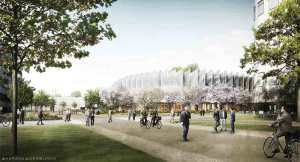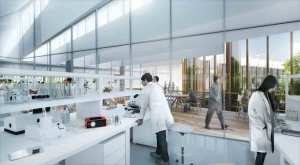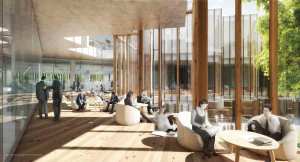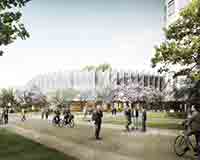 If you think Cambridge has already cemented its location as the UK’s foremost location for pharmaceutical and biomedical occupiers, you ain’t seen nothing yet.
If you think Cambridge has already cemented its location as the UK’s foremost location for pharmaceutical and biomedical occupiers, you ain’t seen nothing yet.
Approval in February for AstraZeneca’s plans for a new 600,000 sq ft global R&D centre and corporate headquarters at Cambridge Biomedical Campus, housing 2,000 employees by 2016, represents an inward surge of life sciences expertise that agents expect to have a knock-on effect for the property market. The only question now is just how significant the “AstraZeneca effect” will be.
While Cambridge has traditionally had a solid base of scientific property requirements, the indirect effect of a large occupier putting its faith in the city for a hub of such scale is already catching the eyes of the bigger players in the hi-tech sector, according to agents.
 “It has to be a game changer because of its magnitude,” says Will Heigham, head of office agency at Bidwells in Cambridge.
“It has to be a game changer because of its magnitude,” says Will Heigham, head of office agency at Bidwells in Cambridge.
“There is a buzz about the place. The companies looking for space have matured. The door seems to be opening up and people are realising, ‘we need to be in Cambridge’,” adds Rob Sadler, head of Savills’ Cambridge office.
Among them is Apple, which has taken around 9,000 sq ft at 90 Hills Road for R&D uses. Chinese mobile and telecoms firm Huawei is believed to be under offer on space at Cambridge Science Park, while music streaming provider Spotify is biding its time to find the right location in the city, having scouted several buildings (see Offices, pxx).
In addition, AZ has itself taken around 50,000 sq ft at Cambridge Science Park for lab and office space, alongside 40,000 sq ft of offices at Melbourn Science Park, both on five-year leases. Alongside existing space at Granta Park, sources say the company is also set to occupy around 30,000 sq ft at Unex’s Academy House on Hills Road.
 Tom Vantreen, associate director at JLL, which advises AZ, agrees that the effect of the move since its announcement in 2013 has helped a healthy office market in Cambridge improve further.
Tom Vantreen, associate director at JLL, which advises AZ, agrees that the effect of the move since its announcement in 2013 has helped a healthy office market in Cambridge improve further.
“Cambridge is already an established and mature market with clustering and collaboration between companies, plus a large talent pool from which to draw upon. Further market activity and inward investment will follow as Cambridge reinforces its position as a leading global bioscience destination,” he says.
The effect of increased demand has already caused some to fear a squeeze on supply, which in the medium term is pushing rents up.
“The impact of AstraZeneca taking interim space has been felt already. There is a supply imbalance when 100,000 sq ft of space is taken out from the marketplace in one calendar year and there aren’t that many other options,” says Duncan Quig, who heads LSH’s science, tech and advanced engineering team and is based in Cambridge.
“Without AZ, demand would perhaps not be quite so strong. At the moment we are turning away requests for shorter leases and it feels like rents are going up month-on-month. The game for occupiers at the moment is not to try to engineer value, it is to try to secure the space at all.”
The most obvious example of where the supply pipeline has taken a hit is, of course, the AZ site itself. The 2020 Vision for the Cambridge Biomedical Campus has been fulfilled several years early with take-up outstripping projections by some margin, thanks to AZ’s patronage.
“A huge quantum went in one hit and I do not think the expectation was that that would happen. We are now looking at the phase 2 land,” says Heigham of Bidwells, which is agent for the site alongside Savills.
The move also represents a subtle shift south in the geography of Cambridge’s science occupiers, which have traditionally clustered on the northern edge of the city. The sale of the Spicers site in Sawston – around seven miles south of Cambridge – to a US biomedical firm emphasises the point (see box).
Grade-A rents have already risen strongly in the past three years – by around 10% on the northern fringe science parks, says Sadler. The headline city centre rent is now £34 per sq ft, while prime lab space has reached £29 per sq ft, according to data from Bidwells. The firm forecasts a rise to £39 per sq ft for city centre space by 2019.
This heat is not purely a product of factors affecting the Cambridge market in isolation, though. The fact that King’s Cross, Google’s home-in-waiting, is less than 50 minutes away by train will not be lost on any tech occupier eyeing the area.
Says Sadler: “King’s Cross rents have doubled in the past few years. Companies with a HQ in London may look at having R&D in Cambridge. It’s to be expected that you would see some patterns and synergies.”
Housing under pressure?
Alongside an uptick in commercial rents, some agents predict a similar upward pressure on residential prices caused in part by the influx of AstraZeneca workers and their families.
Ed Meyer, head of residential at Savills’ Cambridge office, believes the spin-off effects of the AZ relocation will cause a further influx of new companies, all of whom will require housing for staff.
“Add to the mix of investors an increasing number of London commuters who are moving to Cambridge in search of education opportunities for their children, and it is clear that the residential market is under pressure from all angles,” says Meyer, who notes that 23% of buyers in the city commute to London.
Cambridge council’s Housing Strategy 2012-15 has lowered residential development forecasts from 19,000 to 14,000 new units by 2031, despite proposed new development “on the southern, north-western, eastern and north-eastern urban fringes” and “further growth taking place around Cambridge Station”.
Based on house price-to-earnings ratio, the city is reckoned by Lloyds Bank to be the UK’s 9th least affordable city for housing, and Meyer questions whether the level of development will be enough to change this.
“Despite the amount of new residential development, there is insufficient stock to meet demand, which is why prices in the city will continue to outstrip those in the county and region at large,” he says.
US cancer drug specialist buys Spicers site at Sawston
A US company specialising in innovative cancer treatments is taking on the 500-acre site formerly occupied by office supplies firm Spicers near Sawston, south of Cambridge, which first came to market in 2012.
EG has confirmed that the buyer is Northwest Biotherapeutics, a Maryland-headquartered, NASDAQ-listed company, acting through a UK subsidiary, Aracaris Capital.
Documents filed with the US Securities and Exchange Commission reveal two purchases by Aracaris of sites near Cambridge last year.
The first, in July, covers five parcels of land, which includes farmland, close to the A130 and A1301 neighbouring Sawston and Little Shelford, bought for £13m.
A second acquisition in December adds a further 12 acres of “potentially developable land” for a total of £5m. Regarding this site, NW Bio advises its investors that planning approval will be required for “removal of existing structures” and “approval of the intended use after reclassification”.
It is unclear whether the occupier will seek a development partner to deliver its vision. However, the SEC document adds: “The company plans to explore various structures and approaches for financing and/or development of the property that may enable the company to withdraw its capital from the property.”
NW Bio intends to use the site for the manufacture of its own DCVax product, a “vaccine” for certain types of cancer, which retrains a patient’s own immune system to recognise and attack the disease. Trials of its latest DCVax-L treatment are under way in Cambridge, Birmingham and London.











